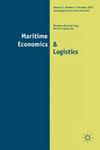全球集装箱航运网络的演变:港口连通性与贸易社区结构(2011-2017)
IF 4.8
3区 工程技术
Q2 TRANSPORTATION
引用次数: 0
摘要
港口连通性和贸易社区结构是两个基本的网络特征,它们在解释海上运输网络的演变过程中是相辅相成的。虽然文献对港口连通性进行了广泛的研究,但对贸易社区结构的研究却相当有限。为了更好地填补这一空白,本文旨在基于我们在MEL的早期工作,提供全球集装箱航运网络(GCSN)发展的更完整的图景。在此过程中,首先构建GCSN,代表从2011年第三季度到2017年第三季度每个季度末的交易快照。然后分别通过集装箱港口连通性指数和Louvain算法提取港口及其各自贸易社区的连通性。通过我们提出的框架,相关参与者将能够了解GCSN的发展,以及海事事件对集装箱航运网络的影响。我们的计算结果表明,港口连通性和贸易社区结构随着时间的变化而逐渐演变,这两个解释变量可以很好地解释GCSN的演变。在这方面,东亚港口在入境和出境连通性方面一直领先于其他港口,以上海和中国大陆其他主要港口为首。此外,贸易社区的形成在很大程度上取决于贸易模式,而不是地理位置,这一点从2016年巴拿马运河扩建后北美地区社区的破产和合并中可以明显看出。本文章由计算机程序翻译,如有差异,请以英文原文为准。
An evolution of the Global Container Shipping Network: port connectivity and trading community structure (2011–2017)
Abstract Port connectivity and trading community structure are two fundamental network characteristics that complement one another in explaining the evolution of maritime transport networks. Although port connectivity has been widely studied in the literature, the investigations on trading community structures are rather limited. To better fill this gap, this paper aims to provide a more complete picture of the Global Container Shipping Network (GCSN)’s evolution, based on our earlier works in MEL. In doing so, the GCSN, representing a snapshot of trade at the end of each quarter, from Q3/2011 to Q3/2017, is first constructed. The connectivity of ports and their respective trading communities are then extracted by the Container Port Connectivity Index and the Louvain algorithm, respectively. With our proposed framework, related players would be able to understand the growth of GCSN, as well as the impacts of maritime occurrences on the network of container shipping. Our computational results indicate that port connectivity and trading community structure gradually evolve according to the economic conditions that change over time and the evolution of GCSN could be well explained by these two explanatory variables. In this regard, ports in East Asia consistently dominate others in terms of both inbound and outbound connectivity, led by Shanghai and other major ports of mainland China. Furthermore, the formation of trading communities largely depends on trading patterns—rather than geographical locations—which is evident from the insolvency and mergers of communities in the North American region right after the expansion of the Panama Canal in 2016.
求助全文
通过发布文献求助,成功后即可免费获取论文全文。
去求助
来源期刊

Maritime Economics & Logistics
TRANSPORTATION-
CiteScore
8.00
自引率
13.00%
发文量
46
期刊介绍:
Maritime Economics & Logistics (MEL) is a peer-reviewed quarterly scientific publication committed to the methodological analysis of global supply chains; that is, ocean transportation, ports, marine terminals and maritime logistics. Papers are expected to be thoroughly researched, scientifically rigorous, and at the same time, of direct applicability and usefulness to practitioners and policy makers alike. All contributions are subject to strict peer-review.
Often, MEL includes a special section under the heading ''Policy Perspectives''. Papers here, often solicited ones, emphasise strategic policy implications rather than scientific rigour in a strict sense. Papers in Policy Perspectives are subject to lighter peer review; this results in speedier publication. Papers submitted to MEL are submitted for both sections at the discretion of the Editors. Authors not wishing to have their papers considered for Policy Perspectives should state this in the Cover Letter.
 求助内容:
求助内容: 应助结果提醒方式:
应助结果提醒方式:


